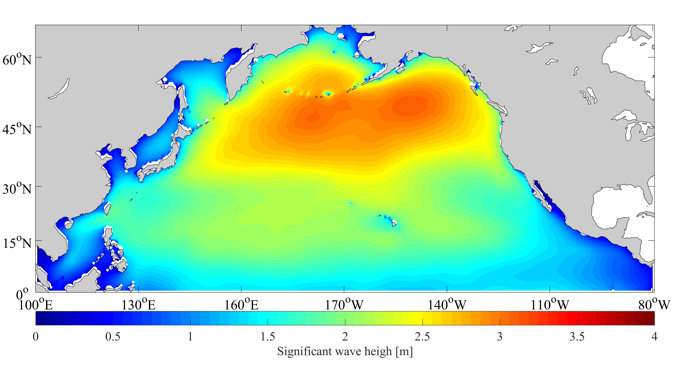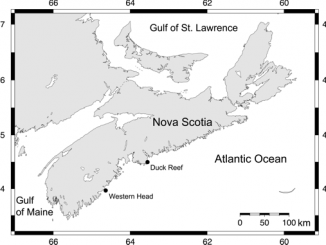
Paper category: Original research paper
Corresponding author: Jian Shi (shijian.mil@163.com)
DOI: 10.2478/ohs-2019-0034
Received: 06/01/2019
Accepted: 07/05/2019
Full text: here
Citation (APA style): Liu, J., Shi, J. & Zhang, W. (2019). Numerical simulation of the wave-induced Stokes drift effect on sea surface temperature in the North Pacific. Oceanological and Hydrobiological Studies, 48(4), pp. 381-403. Retrieved 10 Dec. 2019, from doi:10.2478/ohs-2019-0034
Abstract
The effect of the wave-induced Stokes drift is not taken into account in traditional ocean circulation models used for SST simulations. The spectral parameterization scheme is considered to be the most accurate of the wave-induced Stokes drift calculation schemes. The numerical simulation results of sea surface temperature (SST) with the Stokes drift and SST without the Stokes drift in the North Pacific in 2014 were analyzed. The Stokes drift plays a cooling role in the North Pacific, and the most affected areas are high-latitude sea areas. The following factors are responsible for cooling: the seawater divergence caused by Stokes transport, changes in the sea surface current field caused by the Coriolis-Stokes force and the effects of turbulence caused by Langmuir circulation. The simulation of the vertical temperature profile in the mixed layer is improved when the Stokes drift is accounted for. The simulated results of SST using the Stokes drift approximate parameterization schemes and the spectral parameterization scheme are compared. The results confirm that the spectral parameterization scheme can be used for accurate SST simulation, and the Phillips spectrum approximate parameterization scheme is the best among the approximate parameterization schemes.
References
Bell, R. & Kirtman, B. (2018). Seasonal forecasting of winds, waves and currents in the north pacific. Journal of Operational Oceanography 11(1): 11–26.
Bi, F. (2013). Study on the influence of waves on the circulation transport and the dissipation characteristics of the swell wave. Unpublished doctoral dissertation. Ocean University of China.
Breivik, Ø., Janssen, P. A. & Bidlot, J.R. (2014). Approximate Stokes drift profiles in deep water. Journal of Physical Oceanography 44(9): 2433–2445.
Breivik, Ø., Mogensen, K., Bidlot, J.R., Balmaseda, M.A. & Janssen, P.A. (2015). Surface wave effects in the NEMO ocean model: Forced and coupled experiments. Journal of Geophysical Research: Oceans 120(4): 2973–2992.
Breivik, Ø., Bidlot, J.R. & Janssen, P.A. (2016). A Stokes drift approximation based on the Phillips spectrum. Ocean Modelling 100: 49–56.
Chelton, D.B. & Freilich, M.H. (2005). Scatterometer-based assessment of 10-m wind analyses from the operational ecmwf and ncep numerical weather prediction models. Monthly Weather Review 133(2): 409–429.
Chen, G., Chapron, B., Ezraty, R. & Vandemark, D. (2002). A global view of swell and wind sea climate in the ocean by satellite altimeter and scatterometer. Journal of Atmospheric and Oceanic Technology 19(11): 1849–1859.
Craik, A.D. & Leibovich, S. (1976). A rational model for Langmuir circulations. Journal of Fluid Mechanics 73(3): 401–426.
Craik, A.D.D. (1977). The generation of Langmuir circulations by an instability mechanism. Journal of Fluid Mechanics 81(2): 209–223.
Deng, Z., Wu K. & Yu T. (2007). Wave transport in the eastern boundary of the Pacific Ocean. Acta Oceanologica Sinica 29(6): 1–9.
Deng, Z., Xie, L., Han, G., Zhang, X. & Wu, K. (2012). The effect of Coriolis-Stokes forcing on upper ocean circulation in a two-way coupled wave-current model. Chinese journal of oceanology and limnology 30(2): 321–335.
Deng, B. (2015). Research on the influence of ocean waves on the upper ocean. Unpublished doctoral dissertation. PLA University of Science and Technology.
Elfouhaily, T., Chapron, B., Katsaros, K. & Vandemark, D. (1997). A unified directional spectrum for long and short wind-driven waves. Journal of Geophysical Research: Oceans 102(C7): 15781–15796.
Hasselmann, K. (1970). Wave-driven inertial oscillations. Geophysical and Astrophysical Fluid Dynamics 1(3–4): 463–502.
Huang, N.E. (1979). On surface drift currents in the ocean. Journal of Fluid Mechanics 91(1): 191–208.
Huang, C., Qiao, F. & Song Z. (2008). The effect of the wave-induced mixing on the upper ocean temperature in a climate model. Acta Oceanol. 27(3): 104–111.
Jordi, A. & Wang, D. (2012). sbPOM: A parallel implementation of Princenton Ocean Model. Environmental Modelling & Software 38: 59–61.
Kara, A.B. & Hurlburt, H.E. (2006). Daily inter-annual simulations of SST and MLD using atmospherically forced OGCMs: Model evaluation in comparison to buoy time series. Journal of Marine Systems 62(1–2): 95–119.
Kenyon, K.E. (1970). Stokes transport. Journal of Geophysical Research 75(6): 1133–1135.
Langmuir, I. (1938). Surface motion of water induced by wind. Science 87(2250): 119–123.
Lewis, D.M. & Belcher, S.E. (2004). Time-dependent, coupled, Ekman boundary layer solutions incorporating Stokes drift. Dynamics of Atmospheres and Oceans 37(4): 313–351.
Li, J. & Heap, A.D. (2011). Environmental modelling & software. Ecological Informatics 6(5): 228–241.
Li, M., Zahariev, K. & Garrett, C. (1995). Role of Langmuir circulation in the deepening of the ocean surface mixed layer. Science 270(5244): 1955–1957.
Li, M., Garrett, C. & Skyllingstad, E. (2005). A regime diagram for classifying turbulent large eddies in the upper ocean. Deep Sea Research Part I: Oceanographic Research Papers 52(2): 259–278.
Li, S., Song J. & Sun Q. (2008). Effect of Stokes drift on upper ocean mixing. Acta Oceanologica Sinica 27(2): 11–20.
Li, S., Song, J. & Fan, W. (2013). Effect of Langmuir circulation on upper ocean mixing in the South China Sea. Acta Oceanologica Sinica 32(3): 28–33.
Liu Z., Shi J. & Jiang G. (2017). Effects of sea wave mixing on surface temperature simulation of tropical oceans. Journal of Tropical Oceanography 36(4): 77–86.
Longuet-Higgins, M.S. (1953). Mass transport in water waves. Phil. Trans. R. Soc. Lond. A 245(903): 535–581.
Mellor, G.L. (1998). A Three Dimensional, Primitive Equation, Numerical Ocean Model (Users Guide). Available on the Princeton Ocean Model web site: http://www.aos.princeton.edu/WWWPUBLIC/htdocs.pom.
McPhaden, M.J. (1995). The tropical atmosphere ocean array is completed. Bulletin of the American Meteorological Society 76(5): 739–744.
McWilliams, J.C., Sullivan, P.P. & Moeng, C.H. (1997). Langmuir turbulence in the ocean. Journal of Fluid Mechanics 334: 1–30.
McWilliams, J.C. & Restrepo, J.M. (1999). The wave-driven ocean circulation. Journal of Physical Oceanography 29(10): 2523–2540.
McWilliams, J.C., Restrepo, J.M. & Lane, E.M. (2004). An asymptotic theory for the interaction of waves and currents in coastal waters. Journal of Fluid Mechanics 511: 135–178.
Murphy, A.H. (1995). The coefficients of correlation and determination as measures of performance in forecast verification. Weather and forecasting 10(4): 681–688.
Phillips, O.M. (1977). The dynamics of the upper ocean. Cambridge: Cambridge University Press.
Polton, J.A., Lewis, D.M. & Belcher, S.E. (2005). The role of wave-induced Coriolis–Stokes forcing on the wind-driven mixed layer. Journal of Physical Oceanography 35(4): 444–457.
Polton, J.A. & Belcher, S.E. (2007). Langmuir turbulence and deeply penetrating jets in an unstratified mixed layer. Journal of Geophysical Research: Oceans 112(C9).
Qiao, F., Yuan, Y., Ezer, T., Xia, C., Yang, Y. et al. (2010). A three-dimensional surface wave–ocean circulation coupled model and its initial testing. Ocean Dynamics 60(5): 1339–1355.
Rascle, N., Ardhuin, F., Queffeulou, P. & Croizé-Fillon, D. (2008). A global wave parameter database for geophysical applications. Part 1: Wave-current–turbulence interaction parameters for the open ocean based on traditional parameterizations. Ocean Modelling 25(3–4): 154–171.
Rascle, N. & Ardhuin, F. (2013). A global wave parameter database for geophysical applications. Part 2: Model validation with improved source term parameterization. Ocean Modelling 70: 174–188.
Restrepo, J.M. & Mcwilliams, J.C. (2007). Wave current interaction: a comparison of radiation-stress and vortex-force representations. Journal of Physical Oceanography 37(5): 1122.
Reynolds, R.W., Smith, T.M., Liu, C., Chelton, D.B., Casey, K.S. et al. (2007). Daily high-resolution-blended analyses for sea surface temperature. Journal of Climate 20(22): 5473–5496.
Shi, J., Zhou, L. & Yang, L.Y. (2013). Influence of sea spray droplets on drag coefficient in high wind speed. Acta Physica Sinica 62(3): 039201–039209.
Skyllingstad, E.D. & Denbo, D.W. (1995). An ocean large-eddy simulation of Langmuir circulations and convection in the surface mixed layer. Journal of Geophysical Research: Oceans 100(C5): 8501–8522.
Smith, J.A. (1998). Evolution of Langmuir circulation during a storm. Journal of Geophysical Research: Oceans 103(C6): 12649–12668.
Song, Z., Qiao, F. & Yang, Y. (2006). Improvement of cold tongue simulation in the coupled model of ocean-atmosphere in the tropical Pacific by wave-induced mixing. Advances in Natural Science 16(9): 1138–1145.
Song, Z., Qiao, F., & Song, Y. (2012). Response of the equatorial basin-wide SST to non‐breaking surface wave-induced mixing in a climate model: An amendment to tropical bias. Journal of Geophysical Research: Oceans: 117(C11).
Stokes, G.G. (1847). On the theory of oscillatory waves. Transaction of the Cambridge Philosophical Society 8: 441–455.
Sun, F., Zhang, C. & Shang, S.(2007). Preliminary verification of sea surface temperature of AVHRR, TMI and MODIS remote sensing in some parts of the western Pacific Ocean. Journal of Xiamen University: Natural Science 46(s1): 1–5.
Sun, F., Gao, S., Wang, W. & Qian, C. (2004). Wave-induced stress and estimation of its driven effect on currents. Science in China Ser. D: Earth Sciences 47(12): 1147–1154.
Swail, V.R. & Cox, A.T. (2000). On the use of ncep–ncar reanalysis surface marine wind fields for a long-term north atlantic wave hindcast. Journal of Atmospheric & Oceanic Technology 17(17): 532–545.
Tamura, H., Miyazawa, Y. & Oey, L.Y. (2012). The Stokes drift and wave induced-mass flux in the North Pacific. Journal of Geophysical Research: Oceans 117(C8).
Tolman, H.L. & Chalikov, D. (1996). Source terms in a third-generation wind wave model. Journal of Physical Oceanography 26(11): 2497–2518.
Tolman, H.L. (2009). User manual and system documentation of WAVEWATCH III TM version 3.14. Technical note, MMAB Contribution, 276, 220.
Wang, Z. (2012). Study on the influence of Stokes-drift on the upper ocean. Unpublished doctoral dissertation. Ocean University of China.
Wang, Z., Wu, K., Dong, S., Deng, Z.A. & Zhang, X. (2015). Effect of wave-induced Stokes drift on the dynamics of ocean mixed layer. Chinese journal of oceanology and limnology 33(1): 233–242.
Webb, A. & Fox-Kemper, B. (2011). Wave spectral moments and Stokes drift estimation. Ocean modelling 40(3–4): 273–288.
Webb, A. & Fox-Kemper, B. (2015). Impacts of wave spreading and multidirectional waves on estimating Stokes drift. Ocean Modelling 96: 49–64.
Weber, J.E. (1983). Attenuated wave-induced drift in a viscous rotating ocean. Journal of Fluid Mechanics 137: 115–129.
Wu, J. (1982). Wind‐stress coefficients over sea surface from breeze to hurricane. Journal of Geophysical Research Oceans 87(C12): 9704–9706.
Xu, Z. & Bowen, A. J. (1994). Wave- and Wind-Driven Flow in Water of Finite Depth. Journal of Physical Oceanography 24: 1850–1866.
Yan, M., Song, Q., Lin, M. (2016). Cross-alignment analysis of sea surface temperature data of multi-source microwave radiometer in the Northwest Pacific Ocean. Acta Oceanica Sinica 38(7): 32–47.
Zhang, J., Wang, W. & Guan, C. (2011). Analysis of the global swell distributions using ECMWF Re-analyses wind wave data. Journal of Ocean University of China 10(4): 325–330.
Zhang, K., Wu, K. & Hu, B. (2009). Seasonal changes in the North Pacific wave transport and the western boundary flow. Ocean Limae Bulletin (4): 17–24.
Zhang, X., Wang, Z., Wang, B., Wu, K., Han, G. et al. (2014). A numerical estimation of the impact of Stokes drift on upper ocean temperature. Acta Oceanologica Sinica 33(7): 48–55.
Zhang, X., Wang, Z. & Wang, B. (2015). Study on the temporal and spatial distribution characteristics of global Stokes drifting.Marine Sciences 39(1): 93–103.
Zhang, Y. (2013). Study on the influence of wave on energy input and mass transport in Ekman layer. Unpublished doctoral dissertation. Ocean University of China.
Zheng, C., Zhou, L., Shi, W., Li, X. & Huang, C. (2015). Decadal variability of global ocean significant wave height. Journal of Ocean University of China 14(5): 778–782.


Bądź pierwszy, który skomentuje ten wpis